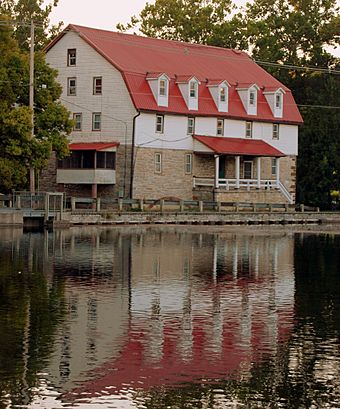Boiling Springs Historic District facts for kids
Quick facts for kids |
|
|
Boiling Springs Historic District
|
|

A Mill in the Boiling Springs Historic District
|
|
| Location | Roughly bounded by High and First Sts., Boiling Springs Lake, and Yellow Britches Creek, Boiling Springs, Pennsylvania |
|---|---|
| Area | 27.9 acres (11.3 ha) |
| Built | c. 1750 |
| Architect | Multiple |
| Architectural style | Bungalow/craftsman, Late Victorian, Federal |
| NRHP reference No. | 84000566 |
| Added to NRHP | December 3, 1984 |
The Boiling Springs Historic District is a special area in Boiling Springs, Pennsylvania. It is located in Cumberland County, Pennsylvania. This district is important because it shows what life was like when iron was made here a long time ago. It also includes many old homes.
This historic district has 127 important buildings, one special site, and one unique structure. These all help tell the story of the area. Most of these buildings were built around the mid-1800s, starting in 1845. Some are even older!
Contents
What is Boiling Springs Historic District?
A historic district is a neighborhood or area that has been officially recognized for its important past. The Boiling Springs Historic District covers about 27.9 acres. It includes the old parts of the town where iron was once a big industry. It also has the neighborhoods where people lived.
This district helps us understand how towns grew around important businesses. It protects the old buildings and places that show this history.
A Look at the Old Buildings
Some of the oldest and most interesting buildings in the district include:
- A grist mill built around 1750. A grist mill is where grain was ground into flour.
- An ironmaster's mansion from 1795. This was the large home of the person who ran the ironworks.
- The Boiling Springs Tavern, which was built in 1832 and has been restored. A tavern was a place where people could eat, drink, and stay overnight.
Other important non-residential buildings are:
- The old stone stables from 1829. Stables were used to house horses.
- A forge building from the 1850s. A forge is where metal was heated and shaped.
The district also has a special stone bridge with three arches, built in 1854. This bridge is a contributing structure, meaning it adds to the historical importance of the area.
Homes and Their Styles
The homes in the Boiling Springs Historic District are also very interesting. They show different styles of architecture from the past. Some common styles you can see are:
- Bungalow/Craftsman style: These homes often have low-pitched roofs and natural materials.
- Late Victorian style: These houses are usually larger with decorative details.
- Federal style: These homes are often simpler and more formal in their design.
These different styles show how building trends changed over time.
Why is This Place Important?
The Boiling Springs Historic District is important because it tells a story about early American industry. The ironworks here played a big role in the local economy. The buildings show how people lived and worked during that time.
By preserving these buildings, we can learn about the past. It helps us understand how communities developed. It also shows us the different types of architecture that were popular.
Becoming a National Historic Site
Because of its rich history and well-preserved buildings, the Boiling Springs Historic District was added to the National Register of Historic Places in 1984. The National Register is a list of places in the United States that are important to history. Being on this list helps protect these special places for future generations.



